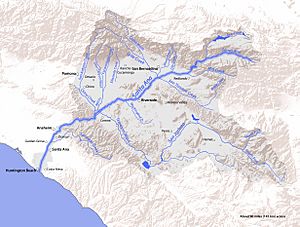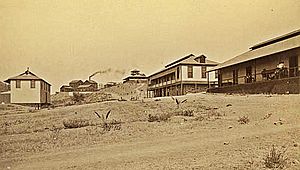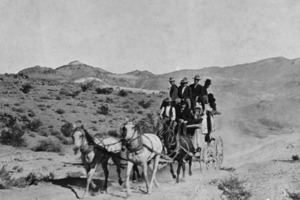Rancho Temescal (Serrano) facts for kids
Rancho Temescal was a large farm area connected to Mission San Luis Rey de Francia. This mission was one of 21 Spanish missions built in California by Spain a long time ago, in the late 1700s and early 1800s. The mission was located where Oceanside, California is today.
A man named Leandro Serrano started Rancho Temescal in 1819. This was the very first settlement in the area that would later become Riverside County, California, that wasn't a Native American village.
Leandro Serrano tried to get official ownership of the land from the Mexican government, but he never received the paperwork. The only proof he had was a note from the San Luis Rey Mission saying he could use the land for grazing animals. After Leandro Serrano passed away in 1852, his wife, Josefa Montalva de Serrano, kept trying to get the land officially recognized. By then, California was part of the United States. But in 1866, the U.S. Supreme Court said her family didn't own the land.
The land Serrano claimed stretched along the Temescal Valley, south of where Corona is now. It included places like El Cerrito and Lee Lake. Back then, Rancho Temescal was part of San Bernardino County. Later, in 1893, Riverside County was created from parts of San Bernardino and San Diego County.
Contents
The Story of Rancho Temescal
Rancho Temescal is important because it has two historic sites from Native American times within its old boundaries.
Leandro Serrano's Life
Leandro Serrano (who lived until 1852) was the son of a soldier who came to California with Junípero Serra in 1769. Leandro was like a manager, called a mayordomo, for the San Antonio de Pala Asistencia, which was a branch of the Mission of San Luis Rey.
Around 1818 or 1819, Serrano got written permission from the mission priest or the military leader in San Diego to use a large area of land called Rancho Temescal. This land belonged to the Mission of San Luis Rey.
The Serrano Boulder (a California Historical Landmark) marks the spot where Leandro Serrano built his first house around May 1824. By 1826, he had an adobe house, a garden with fruit trees, and many cattle and horses. From 1828, Leandro also worked as a mayordomo for Mission San Juan Capistrano.
In the early 1830s, he built a second home on a small hill. This new house had a great view, which was helpful because there were worries about conflicts with Native American groups when the missions in California were being closed down. The remains of this second adobe house were still visible in the 1880s.
In the 1840s, Leandro built his third and final adobe house. It was located on the main road between San Diego and Los Angeles. This road later became part of the Southern Emigrant Trail used by people traveling to California during the California Gold Rush. The Serrano family lived in this adobe until 1898. This third adobe's location is near the corner of I-15 and Old Temescal Road, about 8 miles southeast of Corona. Leandro lived there with his family until he died in 1852.
The Disputed Land Claim
After the Mexican–American War ended in 1848, California became part of the United States. The peace agreement, called the Treaty of Guadalupe Hidalgo, said that old land grants would still be honored.
In 1852, Leandro Serrano's widow, Josefa Montalva de Serrano, filed a claim for five square leagues of land for Rancho Temescal with the Public Land Commission. This was required by a new law called the Land Act of 1851. However, the Commission rejected her claim in 1855.
She appealed the decision, and in 1859, a U.S. District Court said her claim for four square leagues was valid. But then, the case went to the U.S. Supreme Court. In 1866, the Supreme Court ruled that Leandro Serrano had no legal right to the land. They said that simply using land for a long time with permission from a mission priest or military leader didn't create a legal claim to the land.
When the Serrano family lost their claim, they were allowed to keep a 160-acre homestead around their home. Over time, many family members left the valley. Only the mother and her two youngest daughters stayed, growing barley and taking care of their old fruit orchard.
By 1875, most of the rancho's lands were bought by a group of investors for a lot of money. When Senora Serrano passed away, her daughters didn't have money for the funeral. So, they mortgaged their home to the South Riverside Land and Water Company and buried her in the small graveyard at Agua Mansa. In 1898, the two sisters moved to Los Angeles.
Temescal Stage Station and Town
After the 1855 ruling that rejected the Serrano land claim, people known as squatters started moving into the Temescal Valley. They hoped to claim land there under a law called the Preemption Act of 1841.
In 1857, the Temescal Station was set up. This was a stop for the Butterfield Overland Mail stagecoach line. It was a good place to stop, with plenty of wood and water, and it was protected from strong winds. Temescal even had its own post office for a short time in 1861.
Over the next few decades, a small settlement called Temescal grew around this area. By 1860, a place called Greenwade's at Temescal was used as a voting location for the southwestern part of San Bernardino County. There were some problems with voting there that year, which led to a famous court case. It was so intense that one lawyer even shot the other in court before the election results could be decided!
Temescal Community
In 1866, the Temescal School District was formed. Its first schoolhouse was built under a huge sycamore tree. A new school building replaced it in 1889. Temescal also had a post office again from 1874 to 1901.
During the 1870s, the area started to change. Instead of just raising cattle and sheep, people began planting fruit orchards and keeping bees. Bees became a very important way for people in the valley to earn money.
Cajalco Tin Mine
In 1856, a man named Abel Stearns believed that the Rancho Temescal land had valuable tin metal. He bought a share of the property from Serrano's widow. However, he lost a lot of money during a big drought from 1862-1864, so he had to sell his share of Rancho Temescal in 1864.
The Cajalco Tin Mine, located east of Temescal, started to be developed after the 1866 Supreme Court ruling. It began producing tin by 1869. But the ownership of the land was still unclear, so no more mining happened until another Supreme Court ruling in 1888 finally settled the land title.
After the 1888 ruling, experts from England looked at the tin deposits and gave good reports. This led to the creation of the California Mining and Smelting Company in London in 1890. Another company, the San Jacinto Estate, Limited, was also formed by important bankers from London. They bought the Rancho San Jacinto Sobrante, where the mine was now located.
The Temescal tin mine finally opened and operated for the next two years. The town of Temescal grew as many miners came to work there. By July 1892, 136 tons of tin had been produced. The first and only shipment of this tin reached New York on March 30, 1892. The Temescal tin mines soon closed down in 1892. The valuable equipment was later sold, and no one tried to work the mine again until after World War I.
In 1927, the American Tin Corporation reopened the mine. They made many improvements, but the stock market crash of 1929 forced the mine to close again. In 1942, during World War II, the Tinco Corporation reopened the mine to help supply tin for the war effort. Tinco installed a large mill that operated until 1945, when the mine closed for the last time.
South Riverside and Corona
In May 1886, a group called the South Riverside Land and Water Company was formed. Its members included former Iowa Governor Samuel Merrill. This company, focused on growing citrus fruits, bought the lands of Rancho La Sierra and the Rancho Temescal grant. They then planned out the new community of South Riverside.
They also secured the rights to the water from Temescal Creek, its smaller streams, and Lee Lake. They built dams and pipelines to bring water to the new community. In 1889, the Temescal Water Company was created to supply water. This company bought all the land in the valley that had water and started drilling wells. At first, water flowed easily from wells about 300 feet deep. However, they soon had to install pumps to get the water out.
Over time, all the water from both Temescal and Coldwater Creeks was sent into pipelines. Wet areas and springs dried up, and gradually, the valley became dry and empty. Farms and orchards in the central part of the Temescal Valley were abandoned, and the old adobe houses along the stagecoach route crumbled away.
In 1896, South Riverside was renamed Corona. This name came from a 3-mile circular road around the center of the city, which was used for international automobile races from 1913 to 1916. In 1901, the Temescal post office closed and moved to Corona.
Historic Sites of Rancho Temescal
- Painted Rock (California Historical Landmark #190) - This rock has ancient pictographs (pictures painted on rock) from the earliest people in this area. The Santa Fe Railway helped preserve it, and a local club placed a marker about 7 miles south of Corona.
- Carved Rock (California Historical Landmark #187) - These petroglyphs (pictures carved into rock) were made by the Luiseño Native Americans. People say they mean: 'A chief died here. These are his plumes, his portrait, his sign, and the animals sacred to him.' The Luiseño people who lived in Temescal Valley belonged to a group that spoke the Shoshoean language. Sadly, the rock has been damaged by vandals. It is located on the east side of Temescal canyon, 8 miles south of Corona.
- Serrano Boulder (California Historical Landmark #185) - This boulder marks the spot where Leandro Serrano built the first house in Riverside County around May 1824.
- Old Temescal Road (California Historical Landmark #638) - This route was first used by the Luiseño and Gabrieleno Native American tribes. Leandro Serrano built a home here in 1820. Many important travelers used this road, including gold seekers in 1849. It was part of the Southern Emigrant Trail and the Butterfield Overland Mail route. Later, it became Highway 71. The landmark is about 0.9 miles south of the I-15 and Temescal Canyon Road interchange, 11 miles south of Corona.
- Serrano Tanning Vats (California Historical Landmark #186) - These are two large vats that were used to make leather from cow hides. They were built in 1819 by the Luiseño Native Americans under Leandro Serrano's guidance.
- Ruins of Third Serrano Adobe (California Historical Landmark #224) - Located 8 miles southeast of Corona. Leandro Serrano planted orchards and vineyards and farmed the fertile lands of the Temescal Valley. In the 1840s, he built his third adobe house, where the Serrano family lived until 1898.
- Butterfield Stage Station (California Historical Landmark #188) - This was the site of the Temescal Butterfield stage station on the Rancho Temescal land. Here, mail was delivered, and horses were changed for the stagecoaches. The first stagecoach carrying mail from the east left Tipton, Missouri, on September 15, 1858, passed through Temescal, and arrived in Los Angeles on October 7, 1858. The original marker for this site has been removed, possibly due to new housing developments or road widening. The station site appears to be near where Breezy Meadow Lane meets Temescal Canyon Road.
- Corona Founders Monument (California Historical Landmark #738) - This monument honors the people who bought the Rancho La Sierra and Rancho Temescal lands on May 4, 1886, and founded the citrus farming community and town of Corona.






